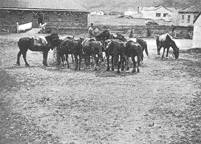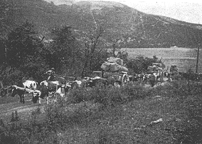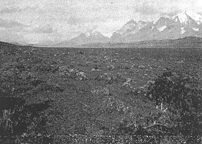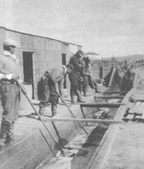Ranch Manager's Report, 1971 [Quotation]
by George Saunders
by George Saunders
George Saunders worked for the SETF at Estancia Cerro Castillo, Ultima Esperanza; read his wife's account of life at Cerro Castillo here.
Introduction
 I worked for 40 years with the
same Company in different parts of Patagonia, i.e. Chile and the Island of
Tierra Del Fuego, on large sheep farms with anything from 90,000 to 160,000
Corriedale sheep on some of the farms, and these farms all ran one sheep per
two acres. All classes of sheep are kept separate in their age groups, and
are only retained for five shearings.
I worked for 40 years with the
same Company in different parts of Patagonia, i.e. Chile and the Island of
Tierra Del Fuego, on large sheep farms with anything from 90,000 to 160,000
Corriedale sheep on some of the farms, and these farms all ran one sheep per
two acres. All classes of sheep are kept separate in their age groups, and
are only retained for five shearings.
Rams are imported from Australia and New Zealand to maintain a good standard of wool.
Cross bred Shorthorn/Hereford cattle are also kept on these farms, but not in great numbers --- about 600 to 1,000 on each farm.
Herding
 All herding of sheep is done on
horseback, and in consequence an average farm needs 500 to 600 horses, as
a shepherd's troop is made up of 6 horses. These animals are bred and tamed
on the farm, and are similar to an Irish hacking horse. Dogs are also used
to help with the herding, and each shepherd has 6 dogs, and this means that
on some farms there maybe as many as 180 to 200 dogs belonging to the shepherds.
All herding of sheep is done on
horseback, and in consequence an average farm needs 500 to 600 horses, as
a shepherd's troop is made up of 6 horses. These animals are bred and tamed
on the farm, and are similar to an Irish hacking horse. Dogs are also used
to help with the herding, and each shepherd has 6 dogs, and this means that
on some farms there maybe as many as 180 to 200 dogs belonging to the shepherds.
Shearing
 The wether hoggets and ewe
hoggets are heavily culled before shearing.
The wether hoggets and ewe
hoggets are heavily culled before shearing.
The sheep are out of doors all the year round, and the only occasion on which they spend a little time under cover is during shearing, which usually takes place in December and January, when they maybe spend some hours in the shearing shed in their stalls, or even overnight awaiting their turn to be shorn.
To have sufficient dry sheep for one day's shearing the shearing sheds are capable of holding 3,000 to 5,000 sheep according to the number of shearers.
A shearing shed may have from 26 to 36 shearers, and they shear approximately 3,000 to 5,000 sheep a day, depending on whether they are shearing rams, hoggets, young or old ewes.
Weather & Terrain
Once the sheep are shorn they are put out in the open immediately to go to their pastures in the high country for the summer, and then they are brought down to the low country in April to be put to their winter Pasture, as the high country cannot be used in the winter months owing to the fact that it may be covered with snow, which drifts badly, and also suffer from hard frosts, ice, and shortage of water.
The weather is similar to that in the North of Scotland. Snow and hard frosts in winter, some rain, and drying winds in the Spring and Summer. The rainfall on an average is about 12 inches per annum, and if there is not a good snowfall in the winter, owing to the drying winds in Spring and Summer there is a lack of moisture which is needed to help with the growth of new grass in Spring, and also the waterholes, lakes, streams and rivers (some of which dry out completely) get very low in water.
 Large areas of land have low
hills and some quite high mountain ranges, and there is also the pampa country
which is completely flat.
Large areas of land have low
hills and some quite high mountain ranges, and there is also the pampa country
which is completely flat.
The weather effects these areas differently as there is not a great deal of forest or trees to give protection, and the pampa just has a few stunted bushes here and there, and one or two small zones covered with a, low bush called Mata Negro. The valleys in the hilly areas give protection to the animals from the wind and cold. At times in Spring and Summer the dust raised by the strong winds can be very trying and unpleasant for the animals, and when there is hurricane force winds this develops into a dust storm.
Winter, which can bring snow in parts, if the wind blows, causes drifts to form of upwards of 10 feet or more, and this causes roads to become closed and travelling very difficult. Sheep are never hand fed even during such bad weather, as it would be an impossible task with such large flocks of sheep, so it is very much the survival of the fittest.
Extra Shearing
The Corriedale sheep has such an abundance of wool growth on the head and face this causes it to become "wool blind" as we say, and it is necessary to shear the head and face twice a year in April and in the Spring - September - especially the ewes before lambing.
Most of this work is carried out where the sheep are in their paddocks, with a portable shearing machine, with four 'shearers and four catchers, and there are permanent pens situated at strategic points, and also portable pens are used for this work. A total of approximately 3,000 to 3,500 sheep can be shorn per day.
This form of working is to avoid driving the sheep long distances to return to the main shearing shed for this operation. Only the sheep which are near the shearing shed are brought to it to have their head and face shorn.
Disease Control
 Sheep are usually
dipped once a year to prevent, and as a precaution against, scab and tick,
and this takes place in April --- before the animals go to their winter camps.
Sheep are usually
dipped once a year to prevent, and as a precaution against, scab and tick,
and this takes place in April --- before the animals go to their winter camps.
Foot rot is rare in this part of the world as the majority of pastures are dry, and it is only on very odd occasions where animals have been in swampy land that it may occur.
As a matter of fact sheep in Patagonia seem to have very
few of the usual sheep diseases which are prevalent in other parts of the
world where sheep are reared in large numbers.
Lambing
The rams are put to the ewes in May to lamb during the first days of October. There is only one lambing per year in Patagonia as the weather is too severe to make it possible to have two lambings. This is the earliest time for lambing as in August and September the weather is still too cold, with hard frosts, sometimes snow, and no green grass for feed. Again the ewes lamb in their very large paddocks and there are so many lambs being born at one time that the weak ones just die, as it would be impossible to hand feed when dealing with such large numbers.
A shepherd looks after approximately 3,000 to 5,000 ewes at lambing time, and owing to the great distances to be covered to do this work he travels around on horseback. These shepherds live in shanties away from the main Settlement to be near their work. Some of these shanties may be as much as 10 to 40 miles from the main Settlement. As many as 3 shepherds may live in one shanty at lambing time to cope with the work. A farm may have 50,000 to 60,000 breeding ewes.
The average for lambs runs between 85% and a 100% in good years. According to the number of young lambs there is you are able to work out how many old ewes, wethers, and lambs that you have for disposal to be sold for meat.
As the weather is so variable here it can effect very much indeed the lambing percentage.
Marking
Lamb marking takes place at the end of November, and can occupy a period of 14 to 21 days according to the size of the farm.
Years ago, the Squad which consists of approximately 30 men, including a cook, and 9 shepherds, lived under canvas, and changed camp every other day. All this was achieved by using horses and horse-carts for transportation of personnel, hats, iron standards. sledge hammers, to enlarge the entrances to the permanent pens, in the large paddocks, for the shutting in of the ewes and lambs, which were in flocks of 2,000 to 2,500 ewes with their lambs.
The first day's work commenced at 3.30 hrs. and usually finished about 15.00 hrs.
This type of working has now altered since mechanical transport became available, and the men and materials for making portable pens etc. are taken every day from the main Settlement in one large lorry, and the cook with his kitchen etc. in a smaller one. By this means it is now possible to mark the same number of lambs, but dealing with them in smaller flocks, averaging 500 to 1,000 ewes and lambs per pen. This also avoids driving the ewes and lambs for long distances, and one does not get so many lambs losing their mothers.
The ewes are shorn last at shearing in January, and the lambs are then weaned from them.